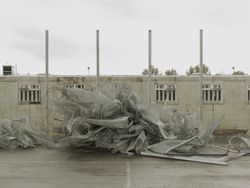ARCH280509
Description:
Table cross referencing the different spaces and specifications (four pages).
1974
Design notes for Robson Square Provincial Government Complex, Vancouver, British Columbia
Actions:
ARCH280509
Description:
Table cross referencing the different spaces and specifications (four pages).
ARCH280511
1974
ARCH280512
between 1973 and 1977
ARCH280504
between 1974 and 1978
ARCH280507
May 1974
PH1981:1286:017
architecture
1912-1914
architecture
PH1981:1286:026
architecture
1912-1914
architecture
PH1981:1286:031
architecture
1912-1914
architecture
The H-Block buildings of Maze Prison were a potent symbol of the often violent political struggles in Northern Ireland known today as the Troubles. The prison, opened in 1971 by the British government, was designed to keep apart warring loyalist and republican paramilitaries, the latter demanding to be treated as prisoners of war rather than criminals. As part of this(...)
Octagonal gallery
5 September 2013 to 12 January 2014
H-BLOCK: Prison Housing – Donovan Wylie
Actions:
Description:
The H-Block buildings of Maze Prison were a potent symbol of the often violent political struggles in Northern Ireland known today as the Troubles. The prison, opened in 1971 by the British government, was designed to keep apart warring loyalist and republican paramilitaries, the latter demanding to be treated as prisoners of war rather than criminals. As part of this(...)
Octagonal gallery
Project
AP075.S1.1974.PR01
Description:
Project series documents Cornelia Hahn Oberlander's project for the landscape of Robson Square Provincial Government Complex in Vancouver, British Columbia. Oberlander worked on this project in 1974-1982 with architect Arthur Erickson and architect Bing Thom. The project consisted in designing a new provincial civic complex that included a courthouse and provincial government offices. The initial plan consisted in a 55-storey highrise. Arthur Erickson suggested to lay the building on its side and spread it accross three city blocks (known as Block 51, Block 61 and Block 71) and add a green roof to create linear park. Oberlander's ideas for the landscape concept was to create a space accessible for everyone that will be attractive and interesting in all seasons. Her design consisted in a series of pathways, stairs and terraces, mainly situated on Block 61, and rising gradually up to 30 feets above the Robson street level. The design was intented to "encourage pedestrians to cut accross the urban grid". [1] Planters where included to buildings facades to create a hanging garden using hanging plants. The project series contains design development drawings and working drawings for the landscape design, such as landscape plans, landscape sections, elevations and details, grading and irrigation plans, and planting plans. The drawings includes in this project series also comprises plans of the complex buildings used as reference. The majority of the drawings are reprographic copies. The series also comprises five original sketches by Oberlander. The project is also documented through interior and exterior photographs of the building, photographs of the landscape and various views of the completed complex. The project series also includes textual records, including documents related to the plants selection, specifications, financial documents, concept development notes of Oberlander, correspondence with architects, clients and consultants, documentation and research material, and clippings and articles on Robson Square project. Source: [1] Herrington, Susan. Cornelia Hahn Oberlander: Making the Modern Landscape, University of Virginia Press, 2014, 304 pages. p. 123.
1970-1995
Robson Square Provincial Government Complex, Vancouver, British Columbia (1974-1982)
Actions:
AP075.S1.1974.PR01
Description:
Project series documents Cornelia Hahn Oberlander's project for the landscape of Robson Square Provincial Government Complex in Vancouver, British Columbia. Oberlander worked on this project in 1974-1982 with architect Arthur Erickson and architect Bing Thom. The project consisted in designing a new provincial civic complex that included a courthouse and provincial government offices. The initial plan consisted in a 55-storey highrise. Arthur Erickson suggested to lay the building on its side and spread it accross three city blocks (known as Block 51, Block 61 and Block 71) and add a green roof to create linear park. Oberlander's ideas for the landscape concept was to create a space accessible for everyone that will be attractive and interesting in all seasons. Her design consisted in a series of pathways, stairs and terraces, mainly situated on Block 61, and rising gradually up to 30 feets above the Robson street level. The design was intented to "encourage pedestrians to cut accross the urban grid". [1] Planters where included to buildings facades to create a hanging garden using hanging plants. The project series contains design development drawings and working drawings for the landscape design, such as landscape plans, landscape sections, elevations and details, grading and irrigation plans, and planting plans. The drawings includes in this project series also comprises plans of the complex buildings used as reference. The majority of the drawings are reprographic copies. The series also comprises five original sketches by Oberlander. The project is also documented through interior and exterior photographs of the building, photographs of the landscape and various views of the completed complex. The project series also includes textual records, including documents related to the plants selection, specifications, financial documents, concept development notes of Oberlander, correspondence with architects, clients and consultants, documentation and research material, and clippings and articles on Robson Square project. Source: [1] Herrington, Susan. Cornelia Hahn Oberlander: Making the Modern Landscape, University of Virginia Press, 2014, 304 pages. p. 123.
Project
1970-1995





![View of the Provincial Government Demonstration Farm (also known as the Colony Farm) showing paddocks, administrative building [?] and barns, Coquitlam (now Port Coquitlam), British Columbia, Canada](/img-collection/4kn8wyj0sbvbMKaYYVXvWa9NX2o=/500x429/11500.jpg)

![View of the Provincial Government Demonstration Farm (also known as the Colony Farm) showing stables [?], paddock, and outbuilding with cornfield in the foreground, Coquitlam (now Port Coquitlam), British Columbia, Canada](/img-collection/9yZ2UAbRtjJkKJQlQGzgxu5sqxE=/500x388/11516.jpg)
